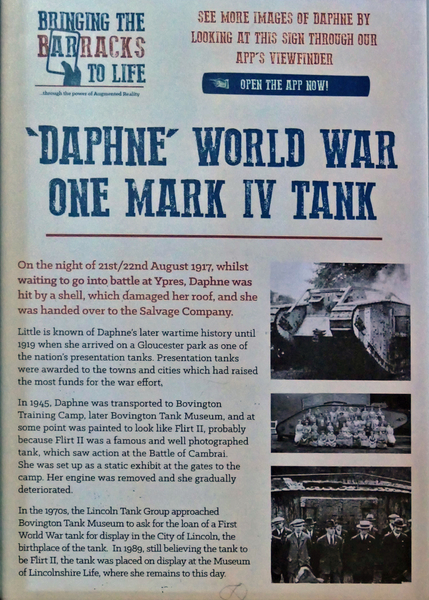
In 1915 at a meeting held in the White Hart Hotel, Lincoln, the design for what was to become the British Army’s fighting tank was born.
The White Hart Hotel,
Bailgate,
Lincoln
LN1 3AR
In 1915 trench fighting was well established, but it was becoming obvious that some form of equipment which could traverse the ‘No Man’s Land’ of broken ground, barbed wire and machine gun fire, was desperately needed. The Admiralty Landship Committee realised that some form of ‘landship’ was needed in order to fight this war on such difficult land terrain. A meeting was held in the Summer 1915 between William Ashbee Tritton, Managing Director of William Foster, a Lincoln engineering firm; his chief draughtsman William Rigby and W. G. Wilson, a Naval Officer.
The latter was working for the Royal Navy Air Service ‘Landships Committee’ (the infant air force was initially under the control of the Navy), and was an overseer at Burton-on-Trent where the Committee had an experimental ground, so also had to stay at the White Hart where he joined the team in the evenings. Here they designed the No. 1 Lincoln Machine; Little Willie and Mother. Glanfield (The Devil’s Chariots) says they burned the failed designs in the fireplace at the end of each day’s work!
From this emerged the designs for what was to become known as the ‘tank’ (the project was disguised as construction of water tanks for Mesopotamia), and several hundred came to be subsequently built in Lincoln.
Only 37 days were needed to build a prototype tank, which was tested on waste ground near the Foster’s factory. Re-design of the tracks was required, so the next version was known as Big Willie, but renamed Mother. On 29th September 1915, military dignitaries came to see what was happening at Foster’s factory in Firth Rd. Lincoln. In a marquee a wooden mock-up of the new weapon was presented to them. So impressed were they that the builders were instructed to have the complete machine ready for testing as soon as possible.
William Foster & Co. Ltd. built all the prototypes and a number of production machines including 37 Mark 1 tanks; 25 Mark 11 tanks; 100 Mark IV tanks; 200 Medium A Whippet tanks and some 36 Medium C Hornet, all together a total of about 400 built during WW1. Other construction was contracted to companies around England.
There is no doubt about the significance of the Fighting Tank on the duration and outcome of the First World War. The site of its development is therefore significant, and that it should be a hotel (rather than an industrial site), and in such an ancient city, is the more remarkable.
A dinner was held in the White Hart and a menu is preserved in the Yarborough Room (known as the ‘Tank Room’). It reads: ‘Complimentary Dinner to Sir William Ashbee Tritton and Major W G Wilson CMG to Celebrate their Official Recognition as the Originators and Designers of the Fighting Tanks.’
The Museum of Lincolnshire Life in Lincoln holds a surviving MKIV tank, known as Daphne, but this was built in 1917 by the Metropolitan Carriage & Wagon Works in Birmingham (famous as a manufacturer of railway rolling stock), so unfortunately it is not a ‘home bred’ Lincoln tank. The invention of the tank has been commemorated in Lincoln with the Lincoln Tank Memorial which has been erected on a roundabout at Tritton Road, in the City.

Grateful thanks to the Tank Museum, Bovington, and to The Lincoln Tank Group, for their assistance with background information.
The National Transport Trust Red Wheel heritage Plaque was erected in November 2020 and unveiled on Wednesday 15th September 2021 by Toby Dennis, Lord Lieutenant of Lincolnshire together with Judy, Lady McAlpine President National Transport Trust; Stuart Wilkinson, Chairman NTT; Councillor Jackie Kirk, Right Worshipful the Mayor of Lincoln; Michael Williams, Mayor’s Consort;
Video of the unveiling ceremony and explanation of the significance of the First Fighting Tank:
This video was produced and Directed by Andrew Blow (ex-ITV Yorkshire) and supported by The White Hart Hotel - with thanks.
This entry compiled by Brian Ward
White Hart Hotel is in the centre of Lincoln, very close to the Cathedral
The Devil’s Chariots - John Glanfield, Sutton Press 2001
Tanks 1914 – 1918 Lt. Col. Sir A W Stern, Hodder & Stoughton 1919
The Landships of Lincoln - Richard Pullen, Tucann Design & Print 2003/2009
Track Prints - Richard Pullen, Tucann Design & Print 2006
Beyond the Green Fields - Richard Pullen, Tucann Design & Print 2008
Chasing von Lettow Vorbeck, WWl in E. Africa - R. Pullen, Tucann D&P 2012
The Tank Papers - The Lincoln Tank Group 1988
Lincoln, Birthplace of the Tank - Lincoln City Council
Birth of the Tanks DVD, Richard Pullen, Blow by Blow Productions: 2021